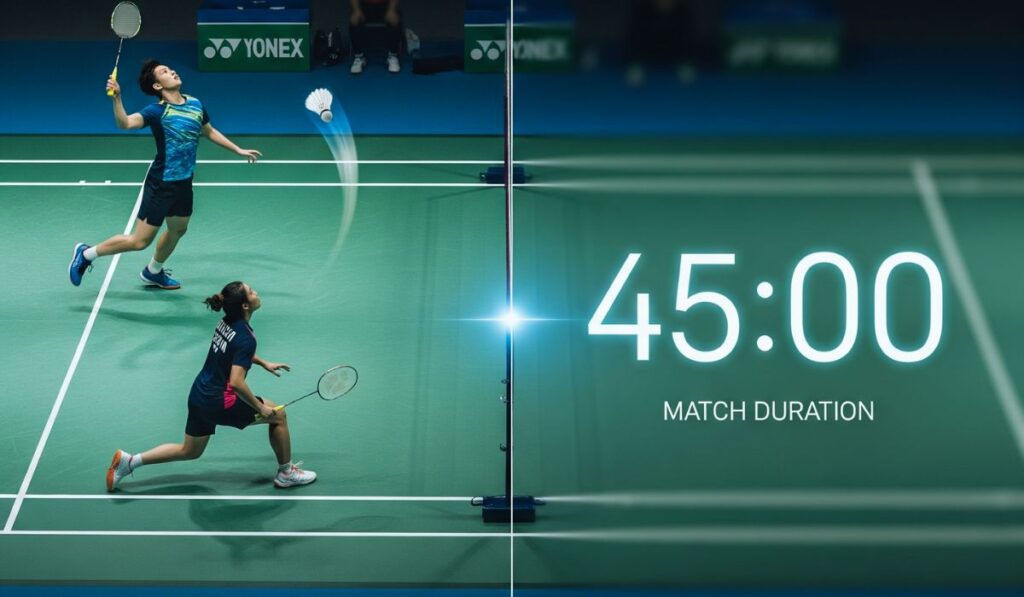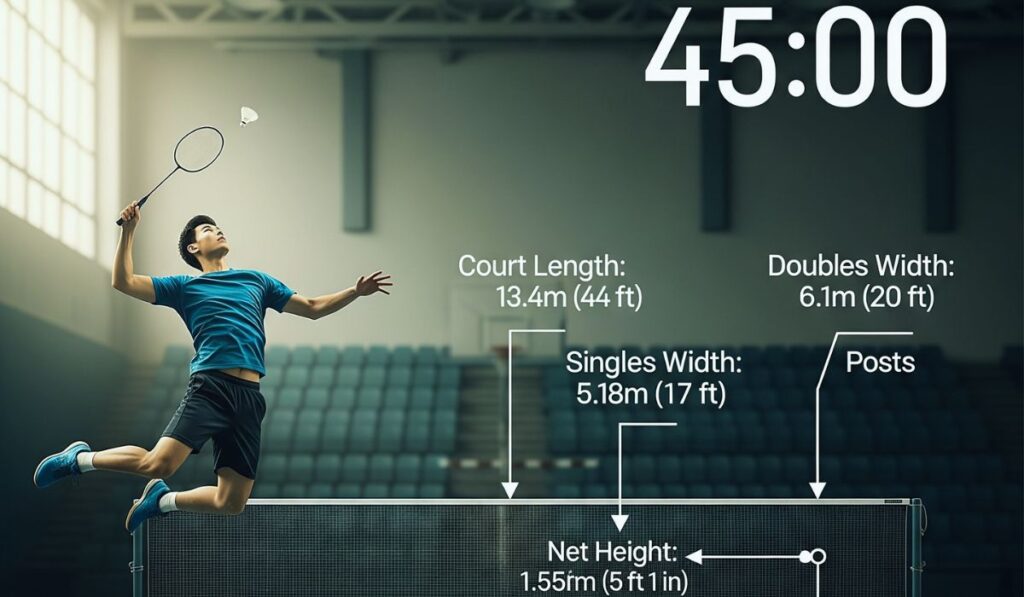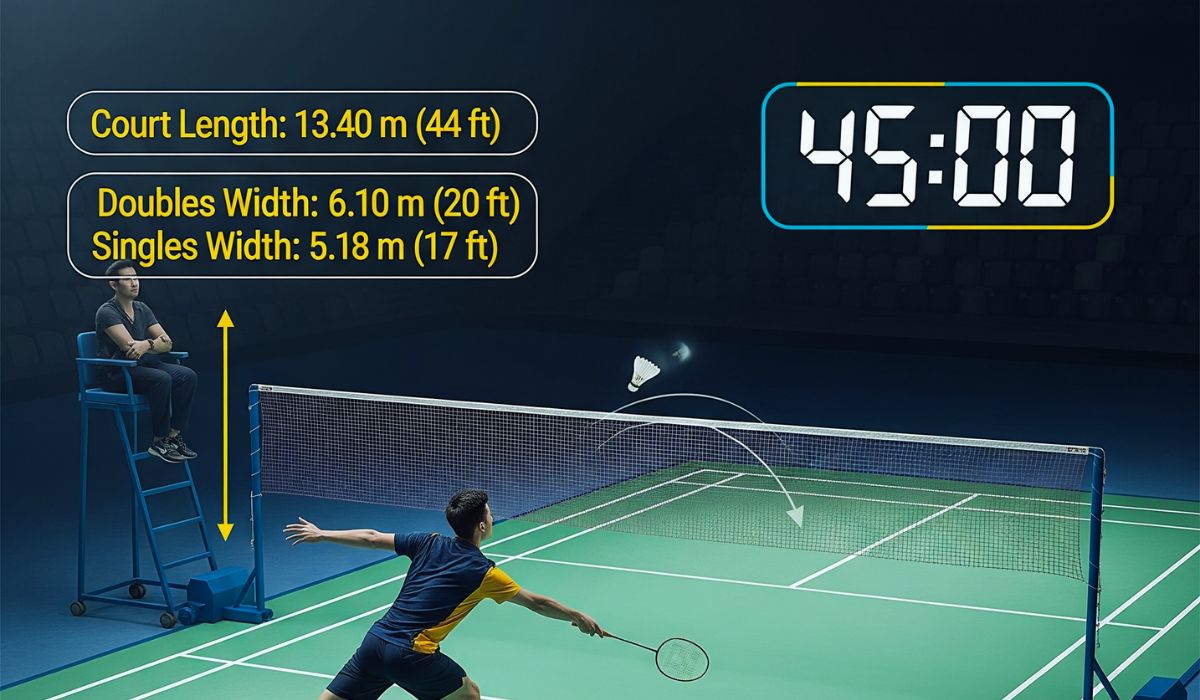“The Ugly Truth About Badminton Time Duration—And the Surprising Secret to Winning Longer Games”
Time Isn’t Just a Number in Badminton—It’s Everything
There’s a certain thrill that crackles in the air when the shuttle is lifted and the first serve slices across the court. But underneath the feathers and flurry lies a question that many players, fans, and even coaches underestimate—how long does a badminton match actually last? The badminton time duration is not just a matter of clock-watching. It’s a journey that weaves together physical stamina, mental resilience, and emotional intensity. Whether you’re a weekend warrior or a world-class professional, the time you spend on court tells a story—one of sweat, rhythm, momentum, and collapse.
The truth is, Badminton time duration isn’t bound by rigid time the way some sports are. Instead, it flows. And within that flow lies opportunity—or downfall. For those who master time, the court becomes a stage of fluid dominance. For those who misjudge it, even talent can’t save them.
What the Rulebook Says: Breaking Down the Structure
Let’s start with the technicals. According to the Badminton World Federation (BWF), a standardBadminton time duration match is played in a best-of-three games format, with each game played to 21 points under the rally scoring system. You win a game by reaching 21 points with a minimum lead of two. If the score reaches 20-20, the game continues until one side leads by two points, up to a maximum of 30.
This might make it seem like Badminton time duration matches have a predictable duration. But here’s the twist—there’s no set time limit. A single game can be as brief as 10 minutes or stretch beyond 30, depending on the players’ intensity, style, and endurance. A full match? That can last between 35 to 75 minutes on average—but some epics go longer. Unlike sports that run on a clock, Badminton time duration runs on tension and score. You don’t watch the minutes. You feel them.
The Emotional Landscape of Time in a Match
The passing of Badminton time duration during a Badminton time duration match isn’t linear. It swells and shrinks depending on your performance. When you’re in the zone, time flies. The shuttle seems slower, the court feels smaller, and the points accumulate like a heartbeat in rhythm. But when you’re lagging—when every rally feels like a test—time stretches. Each second feels exaggerated. You hear your breath louder. You feel your legs heavier. You wonder how long this match has been dragging on.
That’s why understanding the badminton time duration isn’t just about planning schedules or training routines. It’s about psychological readiness. The body may train for rallies, but the mind must prepare for the marathon. That emotional contrast—between flow and frustration—is what gives the sport its irresistible intensity.
Fast and Furious or Slow and Strategic? How Play Style Affects Match Length
Not all badminton matches are created equal. Some blaze by like wildfires—quick attacks, relentless smashes, short rallies. Others are wars of attrition, filled with long exchanges, delicate drop shots, and patience. What makes the difference? Play style.
An aggressive doubles match might last only 30–45 minutes, packed with rapid-fire shots and minimal pauses. In contrast, a strategic singles match, especially at professional levels, can stretch beyond an hour as players test each other’s limits rally after rally.
Your approach to the game influences not just outcomes but time itself. If you like to dominate with quick points, you might finish matches fast—but can you last when someone drags you into deeper water? That’s where Badminton time duration becomes your opponent. The longer the game, the more layers of fatigue, focus, and emotion you must peel through.

The Role of Intervals and Rest Periods in Match Duration
Matches aren’t just played continuously. They’re structured with built-in breaks that give players Badminton time duration to reset, refocus, and strategize. According to official rules, players get a 60-second interval when the leading player reaches 11 points in each game. Between games, there’s a 2-minute break.
These short moments are deceptively powerful. In just 60 seconds, a coach can shift a player’s mindset. In 2 minutes, a tired body can start to recover. But here’s the catch—when emotions run high, even rest can feel like pressure. You’re not just catching your breath; you’re grappling with what’s gone wrong or right. Those seconds become an emotional battlefield. They affect how you play the next rally, and that, in turn, alters the badminton time duration. A lost lead can make a match drag painfully. A comeback? It can make an hour feel like mere minutes.
Why Time Feels Different in Amateur vs. Professional Badminton
Ask any amateur and they’ll tell you a match felt like forever. Ask a pro and they’ll say it went by in a blur. Why? Because time behaves differently depending on your experience. For newer players, every shot is a decision, every rally a gamble. The constant processing slows things down mentally. That mental load makes time feel heavier.
For seasoned players, however, reactions are instinctive. They don’t think—they feel. And because they trust their movement and judgment, matches feel smoother and quicker. That’s why two players in the same 50-minute match might describe it entirely differently. Understanding badminton time duration means realizing that time isn’t just something you measure. It’s something you experience.
How Conditioning and Endurance Shape Time Management
It’s easy to talk about time when you’re fresh. But what happens when your legs are trembling, your lungs are burning, and you’ve already played two 25-minute games with barely a moment to breathe? This is when time becomes a weapon. If you’re well-conditioned, you use the ticking minutes to outlast your opponent. If not, the same minutes become punishment.
Elite players train not just for skill but for energy sustainability over time. They learn how to pace themselves, how to surge at the right moment, how to recover between rallies. This isn’t just physical. It’s deeply sensory. It’s about feeling your body’s rhythm and riding that wave until the final point. That’s why for them, badminton time duration is a tool, not a threat.
The Illusion of Time in Long Rallies
You’ve seen them—those jaw-dropping, heart-stopping rallies that stretch for more than 60 shots. The crowd holds its breath. Commentators lose their minds. And yet, when it’s over, the scoreboard ticks up by just one point. It’s almost cruel how so much effort translates to so little. But in those few minutes, everything intensifies. Time slows. Each motion feels dramatic. Each decision carries more weight.
These moments—where rallies feel like lifetimes—are what make badminton so seductive. You’re not just watching sport. You’re witnessing a dance of stamina, wit, and willpower. And though the rally may only add a minute or two to the clock, it expands the emotional landscape of the match in ways no stopwatch could capture.
How Tournament Format Can Extend or Compress Time
One match is one thing. But a badminton tournament? That’s an entirely different beast. Depending on the stage, format, or number of entries, players may have to play multiple matches per day—each with unpredictable Badminton time duration.
In the early rounds, matches may end quickly if there’s a skill gap. But as the competition tightens, matches grow longer, more tactical, and more mentally demanding. Some players might play three intense matches in one day, with barely a few hours in between. Over a tournament weekend, that means managing multiple hours of playtime, across various opponents and emotional states.
Here, the smart player is not just playing to win—they’re playing to preserve energy across time. Because every unnecessary minute on court today could cost you tomorrow’s match.
The Impact of Delays, Challenges, and Interruptions
It’s easy to imagine Badminton time duration as smooth and uninterrupted. But in reality, delays, injury timeouts, shuttle changes, and even line-call challenges can all drag out the time duration of a match. A challenge that gets reviewed and overturned can break the flow. A minor injury needing medical attention can reset momentum. Even a disagreement with the umpire can cause a few minutes of emotionally charged stillness.
For the viewers, these moments might feel like breaks. But for the player, they’re disorienting. They fracture rhythm. They twist the emotional arc of the match. And collectively, they inflate the badminton time duration beyond what the scoreboard reflects.
Training Smarter by Understanding Match Duration
For athletes who are serious about rising through the ranks, training needs to be tailored not just around technique but around time realities. It’s not enough to just practice 20-minute drills. You have to condition your body and mind for the actual demands of real matches—which can stretch from 40 to 75 minutes in duration. Smart players simulate full match time during training. They mimic the pace of competition, incorporate planned breaks, and recreate tension-heavy rallies. Why? Because playing well for five minutes is easy. Sustaining that excellence over an hour, under pressure, sweat, and fatigue—that’s mastery. And that’s where knowing the badminton time duration becomes a competitive edge. By training with time in mind, you’re not just preparing your body—you’re preparing your strategy. You’ll know when to conserve energy and when to attack. You’ll own the clock instead of being a slave to it.
Youth Matches vs. Adult Games: A Subtle Time Difference
Time behaves differently depending on the level of competition. In junior or youth badminton matches, the games tend to be shorter. Points end faster. The rallies are often less strategic, and players rarely push each other into long, exhausting exchanges. A typical youth match may wrap up in just 20 to 35 minutes. But as the level increases—college, club, national—the badminton time duration naturally lengthens. Advanced players push each other into deeper waters. Rallies stretch. Recovery slows. The tactical tug-of-war grows. The emotional investment increases. These layers contribute to longer matches. So, if you’re moving from amateur to competitive levels, expect time to grow alongside your skill. And plan your training and hydration accordingly. Because one of the most common shocks for progressing players is how time seems to expand—and how unprepared they are to handle it.
Doubles vs. Singles: How Time Differs Across Formats
Many casual players underestimate just how different singles and doubles are in terms of time management. In doubles, the pace is electric. Rallies are shorter. Players cover smaller areas, which reduces exhaustion, even if the speed is higher. As a result, doubles matches—while intense—often finish faster, generally within 30 to 45 minutes. In contrast, singles matches are slower but more drawn out. Players must cover the entire court, leading to longer rallies, more endurance-based points, and badminton time durations that easily exceed an hour in close contests. This means your match format dictates your energy strategy. In doubles, you need explosiveness. In singles, you need patience and pacing. Understanding this isn’t just good for planning your training—it’s essential for knowing when and how to strike during a match.

Televised Matches and Time Management
Ever noticed how matches shown on television or livestreams feel longer? That’s not your imagination. Broadcast badminton matches often include extended pauses between points, more time for replays, challenges, and commercial breaks. This can subtly extend the actual badminton time duration by an extra 10–15 minutes compared to local, non-televised matches. For players, this means dealing with longer downtimes, which can make it harder to maintain intensity. It disrupts rhythm and sometimes cools down muscles. For audiences, though, it adds layers of suspense. Every break builds anticipation. But for the athlete, it’s a test of psychological endurance. You must stay focused and sharp even when the action pauses unexpectedly. If you’re preparing for a high-level event that may be televised, it’s wise to simulate these interruptions during training to keep your mind game strong.
The Sensory Experience of Time on Court
There’s something poetic about the way time feels during a match. It’s not measured by seconds or minutes, but by rhythm, fatigue, and emotion. The feel of the shuttle meeting your strings, the sound of sneakers squeaking on court, the flutter of feathers in the air—all of these amplify or distort time. A short 25-second rally can feel like an entire minute if your heart is pounding and lungs gasping. Conversely, a game-winning 30-minute stretch can feel like a flash of light when you’re riding the high of momentum. Badminton time duration is experienced viscerally. You feel it in your wrists, in your calves, in your breath. And when you’re in tune with the match’s tempo, the clock becomes irrelevant. That’s when you stop playing the game and start becoming one with it.
How Weather and Climate Can Stretch Match Time
You might not expect the weather to affect an indoor sport, but humidity, temperature, and altitude all play a subtle role in stretching or shortening badminton time duration. In warmer climates or poorly ventilated gyms, players fatigue quicker. Sweaty grips, slippery court shoes, and slower shuttle flight can all contribute to longer rallies and more unforced errors. These conditions naturally lengthen matches. In higher-altitude regions, shuttles travel faster, requiring quicker reactions but potentially shorter rallies. Understanding your environment’s impact on time can help you prepare smarter. Bring the right gear. Hydrate aggressively. Warm up thoroughly. It’s not just about staying comfortable—it’s about staying ahead.
The Clock Inside Your Head: How Top Players Manage Time
Badminton time duration management on court isn’t about checking watches. It’s about developing a sixth sense—an internal clock that tells you when to push, when to pause, and when to protect a lead. The best players learn to control the pace. They slow things down when they’re ahead to disrupt their opponent’s rhythm. They speed things up when they’re trailing to regain momentum. This psychological use of Badminton time duration—known as tempo control—can stretch or compress the match at will. It’s one of the most advanced strategies in badminton, and one few amateurs truly master. Learning to feel the time, and then bend it, is what turns a skilled player into a strategic genius.
When Time Becomes the Enemy: Dealing with Long Matches
There comes a point in certain matches where time becomes your greatest obstacle. You’ve been playing for over an hour, the score is tight, and your legs are threatening rebellion. This is when doubt creeps in. Your smashes lose their sting. Your footwork drags. Every second feels like a burden. This is the danger zone. It’s when badminton time duration turns from a neutral factor into a mental enemy. Winning in this phase requires something more than skill—it demands heart. You must dig into emotional reserves, lean into the sensory rhythm of your breathing, and embrace the exhaustion. Champions aren’t made in the first game. They’re made in the moments when time tests you, and you refuse to break.
How Scheduling and Recovery Depend on Match Time
In tournaments that span multiple days, managing your post-match recovery becomes critical. The longer your match, the less time you have to recover before the next one. A 30-minute win keeps you fresh. A 75-minute thriller drains you, both physically and mentally. Smart players adjust their post-match routine based on match duration. Ice baths, light stretches, nutrition intake, sleep quality—all of these become precision tools in conserving energy across the tournament. This is especially important for players competing in both singles and doubles brackets. Understanding the badminton time duration of each match helps you predict and protect your performance in future rounds.
Final Reflections: Time is the Invisible Player on Court
We often think of badminton as a duel between two players. But there’s always a third, silent force on court—time. It shapes decisions. It creates pressure. It rewards patience and punishes haste. It makes rookies panic and veterans rise. Whether you’re a weekend player looking to last longer on court or a rising star preparing for national tournaments, never ignore the role of badminton time duration in your training, preparation, and strategy. Because time is more than a background element—it’s an active, living presence in every match. Master it, and you don’t just play better. You elevate your entire experience of the game.


1 thought on “Badminton time duration”